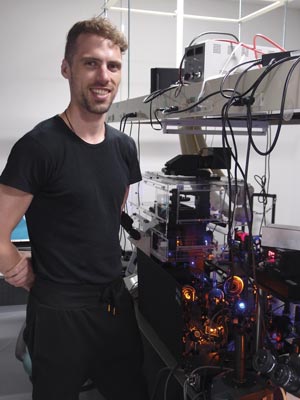May 27, 2016
Listening to the noise
David Priest, Foreign Postdoctoral Researcher

Cell Dynamics Research Core, RIKEN Quantitative Biology Center
Please describe your role at RIKEN.
I work in Yuichi Taniguchi’s laboratory, where I help to develop a deeper understanding of the inherent randomness, or ‘noise’, in biological systems. Living organisms exist far from equilibrium and are engaged in a constant battle against the randomizing and homogenizing forces of nature. While every cell in a clonal population shares the exact same genetic make-up, stochastic events such as transcriptional initiation give rise to large variations between cells and over time. To maintain homeostasis, cells often seek to rein in these stochastic events. We use model organisms to understand the causes and consequences of noisy cellular processes, which will ultimately lead to cures for diseases.
What excites you about your current research?
I was introduced to quantitative biology during my PhD in Keith Shearwin’s laboratory in my hometown of Adelaide, Australia. I have since developed an insatiable appetite for genetics and biochemistry where it intersects with physics and engineering.
During my PhD, I studied my favorite organism, Escherichia coli, using bulk assays, which can measure average gene expression in a cell population. Although convenient and valuable, these types of assays overlook important details, such as cellular heterogeneity and differences between subpopulations, which can only be obtained using single-cell techniques like microscopy. Joining Taniguchi’s lab gave me the chance to learn fluorescence microscopy. I am endlessly excited about using this technique to obtain high-throughput imaging data and then writing computer scripts to analyze the images.
What has been the most interesting discovery in your field in recent years?
The most stunning discovery in the field of noise biology has been that gene expression is not simply a random arrival process (one that follows a Poisson distribution), but that many genes are expressed in ‘bursts’. This bursty transcription causes more variability than a Poisson process, which might be an unavoidable side-effect of controlling genes via binding of transcription factor proteins to their promoter DNA. Increased control might therefore come at the expense of increased noise.
When did you join RIKEN?

I joined RIKEN in the summer of 2014 after applying for a position directly with Taniguchi. I’d encourage interested PhD students to contact lab heads about possible opportunities. Get your foot in the door! If I’d known how rich life is in Japan, I would have tried to come here earlier.
What is the best thing about working at RIKEN?
Putting aside the exceptional facilities, funding and collaboration opportunities, the best thing about RIKEN is the casual atmosphere. One of my mottos is: “the best way to succeed is the relaxed way,” and I’ve found this to be true time and time again. A stress-free working environment gives me the mental space to think deeply about my research and obtain ideas and insights that could save months of misdirected efforts by a stressed-out scientist.
What are your professional and personal goals?
I want to continue developing my skills in high-throughput data acquisition and analysis. Further down the track, I would like to help coordinate other researchers and teach university students. Personally, I seek to maintain a good work–life balance, enjoy precious time with friends, further my yoga practice and perhaps, one day, start a family.
